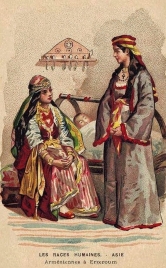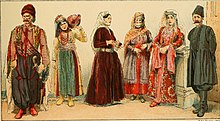Armenian Taraz
Friday, October 13, 2023
The Armenian Taraz, also known as Armenian traditional clothing, reflects a rich cultural tradition.
Wool and fur were utilized by the Armenians along with the cotton that was grown in the fertile valleys. During the Urartian period, silk imported from China was used by royalty. Later, the Armenians cultivated silkworms and produced their own silk.
The collection of Armenian women’s costumes begins during the Urartu time period, wherein dresses were designed with creamy white silk, embroidered with gold thread. The costume was a replica of a medallion unearthed by archaeologists at Toprak Kale near Lake Van, which some 3,000 years ago was the site of the capital of the Kingdom of Urartu.
The Armenian national costume, having existed through long periods of historical development, was one of the signals of self-preservation for the Armenian culture. Being in an area at the crossroads of diverse eastern styles, Armenian dress is significant in not only borrowing but, also often playing an influential role on neighboring nations.
The costume can be divided into two main regions: Western Armenians and Eastern Armenians. Which in turn are divided into separate subregions.

The costume of the Armenians of Western Armenia is mainly divided into two regions:
1. Areas of the Eastern Provinces: Taron (including Sasun), Bardzr Hayk, Vaspurakan, and Baghesh.
2. The regions of Sebastia, Kayseri, Cilicia in the western states, and Kharberd-Tigranakert in the south.
The first group kept closer to the traditions of the Armenian costume while in the second group, the influence of some Anatolian cultures are seen.
Eastern Armenian costume can be divided into three regions:
1. Syunik-Artsakh, Zangezur, and Ayrarat.
2. Goghtan (Agulis, Ordubad)
3. Gandzak, Gugark, Shirak, Javakhk.
Colors
The Armenian costume is dominated by the colors of the four elements: earth, water, air, and fire. According, to the 14th century Armenian philosopher Grigor Tatatsi, the Armenian costume is made to express the ancestral soil, the whiteness of the water, the red of the air, and the yellow of the fire. Apricot symbolizes prudence and common sense, red symbolizes courage and martyrdom, blue symbolizes heavenly justice, white symbolizes purity. Some of the techniques used in making these costumes have survived to this day and are actively used in the applied arts, however, there are techniques that have been lost. Each province of Armenia stands out with its costume. The famous centers of Armenian embroidery - Van-Vaspurakan, Karin, Shirak, Syunik-Artsakh, Cilicia - stand out with their rhythmic and stylistic description of ornaments, color combinations and composition.





